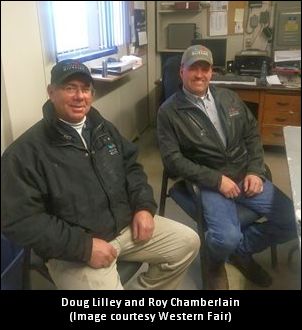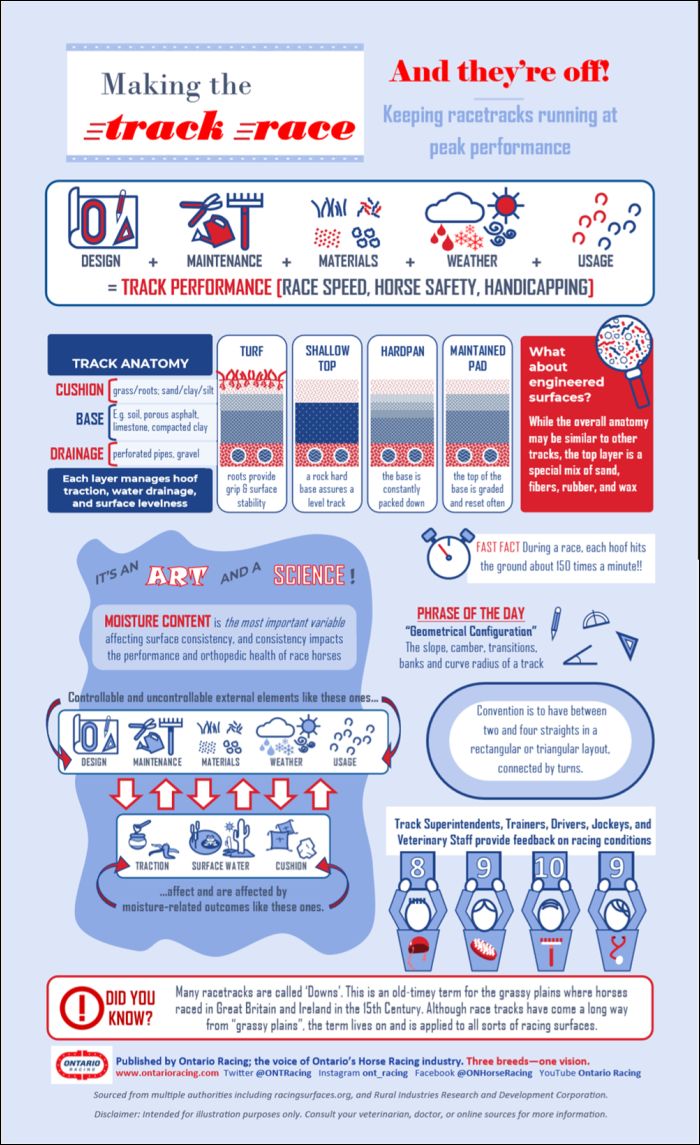
It’s a job that puts the pursuit of perfection at the mercy of Mother Nature.
As Roy Chamberlain and Doug Lilley see it, racetrack surface maintenance is not unlike a Standardbred driver’s bottom line: always stay a step or two ahead of your biggest rival.
For Chamberlain, track superintendent at The Raceway at Western Fair District, and Lilley, track assistant at the London, Ontario oval, their biggest foe rarely gives them a moment to exhale throughout the racetrack’s four-race-days-a-week winter season.
“Always expect the unexpected,” offered Chamberlain, who has been at Western Fair since 2007. “Not just daily, but hourly and weekly. I always try to keep two days ahead of Mother Nature. But she doesn’t always make it easy on you. It’s hard because you’re constantly battling weather and you’re battling timelines to get that track ready for racing. All you want is that fighting chance.”
At this time of the year, they know they’ll take a few on the chin.
Relentless snow, torrential rains, ice pellets, freezing rain – the winter months can deliver a little bit of everything, weather-wise. It also means early mornings, late nights and plenty of question marks leading up to post time.
“You can really let yourself get beat up by the weather,” said Chamberlain. “You can really get stressed out. Eventually, you get to a point where you learn how to deal with it. If it’s going to snow, just be prepared and deal with it.”
On February 9, that’s precisely what the duo had to do.
“That Friday, it snowed the whole day,” said Lilley with a laugh. “It wouldn’t let up. We cancelled our qualifiers late Thursday because we knew what was coming. You wouldn’t be able to keep up with the track being plowed and have it in decent shape.
“There are times when we plow the track two to three times before we even race,” he continued. “There’s only a certain amount of volume you can deal with at once. We plow it down into windrows and then we blow it with the blower. Then you have all the pylons to deal with, getting in and out of them. We have the conditioner right behind us once we’ve plowed down enough. We try to keep the ice off it.”
The pair, who gets a helping hand from Jim McGinnis (who also works in the paddock) when it comes to track work, doesn’t base their track game plan solely on sight. Sound can also play a key factor in any decision-making process.
 “On a snowy night – from race to race – you’re listening to the sound of that track,” noted Chamberlain. “You can hear the sound it makes from when the horses are going over it from one race to the next. It’s more of a thud when there is more snow on the track. Whether it’s the mud or snow, you look for those hoofprints. Once they start punching into the track, it can get dangerous.”
“On a snowy night – from race to race – you’re listening to the sound of that track,” noted Chamberlain. “You can hear the sound it makes from when the horses are going over it from one race to the next. It’s more of a thud when there is more snow on the track. Whether it’s the mud or snow, you look for those hoofprints. Once they start punching into the track, it can get dangerous.”
Lilley often gets an up-close look at the racetrack.
“I always drive the starting gate for qualifiers,” he noted. “We have someone screening the track between qualifiers. To me, one of the most important things is that you have to be working the track yourself to know and understand what the conditions of it are. I was raised on a horse farm, so I’ve been doing this my whole life. I’ve trained horses, managed breeding farms – things like that. You come to understand what the horses like and what they are comfortable racing on.”
Both Chamberlain and Lilley work in concert with the Western Fair horsemen’s committee – a group comprised of local drivers and trainers – to ensure any concerns, questions or suggestions regarding the track are taken into consideration.
“We have a good relationship with the horsemen’s committee at Western Fair,” offered Chamberlain.
Said Lilley, “You get feedback. If there is any issue with the horsemen, they can go to the committee and they can share concerns with us. You usually hear the bad more than the good, just like any typical job. You can have the track perfect nine days out of 10, but you know the one day that it isn’t, you’ll definitely hear about it. One driver likes the track firm and the next one wants more cushion to it. You just do what you believe is best for everyone.”
That same philosophy also applies to the pacers and trotters.
“Every horse is different when it comes to what they like,” said Chamberlain. “You just want to keep it as consistent as you can.”
There are occasions, despite the best efforts and intentions, when the cancellation of live racing is the only option.
Recent steady rains and warm temperatures caused dangerous track conditions that prompted the cancellation of the card after race six on February 19. The following two days of live racing were also shelved.
“We do the track the best we can do,” said Lilley. “You know how you want it, but it doesn’t mean you always get it that way. You’re always looking forward and on what you need to do to have the track in great shape down the road. There are a lot of extra hours that go into doing everything you can to make sure the track is in the best shape possible. But safety is always first. You anticipate certain weather, but then there are curveballs that can come your way. You do the very best you can do. There are times when it doesn’t matter what you do, how long you work at it – the track won’t be perfect. Winter racing is winter racing.”
A sentiment echoed by Chamberlain.
“Winter racing – you just deal with the cards that are handed to you,” he said. “It’s been one of those years. You just try and stay one step ahead of Mother Nature. Sometimes she beats you and sometimes she doesn’t.”
It’s why a kind word every now and again is always appreciated.
“You don’t hear those words every day,” offered Chamberlain. “It’s an occupation where if you don’t hear anything, you’re doing a good job. When you do get them, you appreciate it a lot. The management at Western Fair is good to us and very supportive, which we appreciate.”
But Chamberlain and Lilley never let the words linger.
“Good day or bad, you prepare for the next one,” said Chamberlain. “There’s no time or no need to pat yourself on the back. There’s always the next day. It’s about keeping that one step ahead.”
Even though they know who’s always waiting around the next turn.


